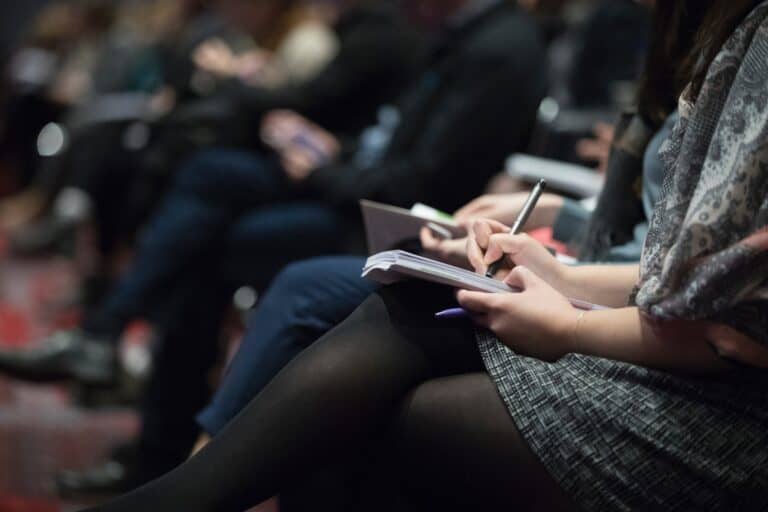8 Ways To Make the Most of Your Next Conference

Attending a conference can be an intense experience. There’s so much information being hurled at you and so many potential connections, clients and partners – it can be overwhelming (at least for me).
But, that’s part of the effectiveness, right? Immersing yourself at a retreats, workshop or an event can catapult you forward with learning and networking, a real boost for your business. Or, it can just be a fun week and then you are back to business-as-usual, with a fist-full of receipts and a notebook full of ideas sitting on a shelf.
Turns out, the real trick is actually USING the information and contacts that you gained. Gah, that darn implementation strikes again! (feel free to picture the Scooby Doo villain here shaking his fist at those meddling kids)
Here’s what’s in my virtual bag of tricks to keep me on track and generating the most bang for my buck when getting my conference on…
Pre-Conference
As with pretty much everything else in business, planning is key. Bo-ring. Yes, but oh-so-very necessary. The bright side is, planning doesn’t have to take a lot of time and can actually be fun as you anticipate what you’ll get when you are at the event.
1. Know Your Schedule
Sure, this one lacks sex appeal, but really, it is the foundation of any event. Get all the sessions, dinners, happy hours, after-parties and breakfasts on your calendar so you’ve got the time and place info at your fingertips. And so you start to make choices about which sessions you’ll attend. I’m assuming that your calendar is perfectly synced across all your devices. If not, fix that.
Many conferences have an app of their own to help you with this. But, if the conference you’re attending doesn’t, you can always create a Google calendar specifically for the event and share it with others. This is a great way to start connecting with attendees even before you get there. Plus, you get some conference karama since it saves others the work of adding all the events to their own calendars.
2. Plan to Get Your Money’s Worth
Once you have the actual conference events and your travel schedule in your calendar, there’s one other critical item to schedule. Follow up time. That’s right, you can put time to follow up and implement the stuff you learned on your calendar even before you attend the event! How much time you ask? Well, that depends.
If you’ve ever registered for college courses, the “rule of thumb” is that you need 2-3 hours of studying for every 1 hour of class. At the time I was registering for college, I knew I’d need some time to study but 2-3 hours seemed like crazy talk. Yeah, it’s not. Actually doing something with the info delivered in an educational session takes TIME.
Back to the question at hand, how much time should you put on your calendar for implementation & follow up after an event? Because conferences and retreats aren’t 100% sessions, there’s also lunch and drinks and stuff, I schedule 50% of the duration of the event for follow up and implementation.
For example, I’m getting ready to head to the MORE Retreat in July. The event runs 1.5 days (12 hours of “conference” time). Thus, I’ve put in my calendar 6 hours for doing follow up and implementation. For a half day event, that would be 2 hours blocked in my calendar for follow up and implementation.
Does that sound like a lot? Sure. But I’d rather block out too much time than have more dusty notebooks and a business that doesn’t move forward. Plus, there’s 2 activities I’m doing in this time. First I’m implementing ideas and strategies in my business, oh – and all that other stuff I got reminded of that fit in with what was being discussed. Second, I’m also following up with people that I met at the conference.
3. Whatcha, Whatcha Want?
The other way I ensure I’m getting a return on my investment in a conference (remember, it isn’t just about registration fees and travel, I’m investing my time too), is making sure I’m clear about what my objectives are for the event.
You might be trying to expand your network, or solve a specific problem in your business. Maybe you just need a fresh perspective on a particular challenge or you want a new partner that provides a complementary service. Whatever it is, be clear on it before you go. That’s the only way to make sure you’ll get what you need.
4. Connect Up on Social
Typically conference websites list speakers and attendees. This is a perfect way to see who it is you want to meet and start your connection on social media before you even get there (I learned this from Stacey). This does not mean you need to friend everyone on Facebook. Rather, you might just “like” their page or even create a Twitter list of influencers or attendees so you can have that handy at the conference.
During the Conference
Now that you’ve arrived, time to let it all sink in. Besides the obvious and standard list of items you should have (water, business cards, snacks, sweater), be sure to also have a portable mobile charger with you. I don’t care how new your phone is, conferences are battery killers. I’ve got a wall charger that is also a portable battery, but one you bought on Amazon or at Walgreens works just as well. This will save you from having to be a wall-hugger during the break.
5. Evernote For The Win
If you aren’t already using this must-have app, a conference is a great place to start. Several people have said to me they just don’t know what to use Evernote for. Well, start with all your conference info. And I mean ALL.
Take your session notes in Evernote (or don’t, I’ll cover that in a minute). Take pictures of exhibitors to follow up with or materials that have good information, and put those in Evernote. Hear about some books you want to read, put them in Evernote. See someone with an amazing outfit? Take a picture and put it in Evernote.
Evernote is truly my everything keeper. That’s because, as techy as I am, I still prefer to take notes with a pen & paper. BUT, I don’t want to have to deal with that paper later. I used to take my notes on paper, then capture them into Evernote with their app Scannable. Scannable, and app from Evernote, quickly transforms my handwritten notes into PDFs and I can upload them into Evernote, or I could share them with others.
Now I have the Rocketbook Wave which is a notebook designed just for batty people like me that need to write notes, but don’t like paper. The concept is the same, take notes, use app to get them into Evernote. But the brilliant part is, when the notebook is full, I just erase it by putting it in the microwave!
Magic paper aside, figure out how you retain information best and then use that method to capture your notes.
6. Business Cards Aren’t For Stacking
A traditional business card is still the fastest way to exchange information with someone new. Yes, there are lots of apps and different technologies out there for swapping contact info, but there’s just not a “universal” one yet. But, fertheluvofgawd, do NOT put them business cards in a stack and take them home to sit sadly on your desk and mock you.
Instead, use an app like FullContact Card Reader or Scannable to scan business cards into your contacts every night or morning of the conference. Then recycle those cards. Personally, I use FullContact and tag the contacts as I scan them for easy follow up and automation (FullContact integrates with Zapier, so I can actually queue up a follow up sequence in ActiveCampaign and kick that off when I scan in a card).
7. Paperless Accounting
By now, I think my loathe of paper is pretty clear. It probably all stems from receipts. These are at the top of my unfavorite things. The good news is, I don’t have to deal with them because I use an app to capture them just as soon as I get them and then I can merrily throw them away.
Scannable, OneReceipt or ShoeBoxed are all fine choices for receipt capturing apps. Find one that fits you & your accounting system and use it. One less thing to pack and deal with when you get home.
Post-Conference
If you’ve played your cards right, post-conference becomes a breeze. You’ve already got time blocked on your calendar, so get out your notes and give them a quick once over. I like to choose 2-3 things that have the largest potential impact and do those first. If there are other ideas or smaller items that can be worked into my regular workflow, I’ll go put those where they belong. Finally, I see if there are other tweaks or adjustments need to be made to my regular workflow.
8. Follow Up Templates That Aren’t Robotic
Timely follow up is critical to keep the momentum of the event and ensure that all the potentially impactful connections you made don’t go cold. To help in that effort, I typically will create a follow up template that I then customize for each of my actually follow up emails.
I use Streak as a CRM inside of Gmail. It has a featured called Snippets that lets me create and easily use a template to start each one of my emails. The point is NOT to just use the email template, the point is to help me not procrastinate following up because I have a starting point for the email.
Sometimes I create the email template ahead of time, sometimes I create it at the event and sometimes that’s one of the first things on my list when I get home. I use that in conjunction with the notes I have on each business card to continue the conversation and connection that got started at the event.
What are your favorite conference “hacks”? Be sure to share them with me in the comments.

